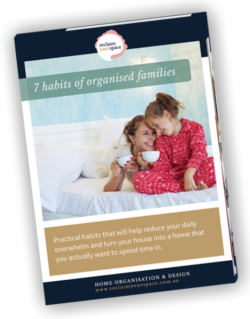Have you been putting off decluttering?
What's your end goal?
- What is the purpose of the space?
- Who will use this space?
- What activities do you want or need to do in this space?
- How do you want to feel in this space?
- Is there something you love about it?
- What isn’t working?
- Which items should and shouldn’t be in there?
Decide where to start decluttering
1. The biggest impact
2. Quickest or easiest
3. Just start
The one thing I can’t stress enough, is to not start with going to the shops and buying organising products.
You may be really excited and have seen some cool looking products, but until you’ve actually gone through your items, even if you don’t get rid of anything, there are a few things you need to know.
First you need to know exactly WHAT you need to store and HOW MUCH of it there is. You also need to identify WHERE to store it, and measure the space and the items in order to find the right storage solution.
3 decluttering methods to try
- Stays in the room/space
- Belongs somewhere else
- Is rubbish
- Can be donated or sold
1. Declutter by item
2. Declutter by end decision
- Get rid of all the rubbish
- Find 10 items to donate or sell
- Collect items that don’t belong in the space.
3. Declutter by category
When you can tangibly see you have ten pairs of scissors, it is easier to make a decision on which two to keep. This not only helps you to make decluttering decisions, but is also the first step to organising the items you will be keeping.
Some final decluttering tips
- Schedule it in. Add it to your to do list or your calendar and commit to doing it.
- Don’t do it alone. Grab a helper, it could be your kids, a friend or a professional organiser.
- Capture your progress. Take a before and after photo.
- Be prepared. You will need a few bags, boxes or tubs for rubbish, recycling and donations. Make sure you also have a box or tub for items that belong elsewhere, a washing basket works great for this.
- Stay focused. Set a timer and don’t leave the space.
- Take a break about once an hour.
- Allow 15 mins at the end to remove rubbish, relocate items and neaten things up.
Congratulations
Reclaim Your Kitchen Blueprint
The kitchen is the busiest and most hard working space in your home. It’s not surprising that it can get out of control!
Are you ready for an uncluttered and streamlined kitchen, optimised for your unique lifestyle? If you have no idea where to start, let me help you get motivated, keep you accountable and get the job done.
Hi, I'm Sarah.
I’m here to support & motivate overwhelmed families juggling the demands of everyday life.
I believe that what’s in your home should be intentional and organised in a way that makes your life easier, reduces your daily decisions and makes you smile 🙂
As a parent I’m all too familiar with that overwhelming feeling that comes from a never ending to do list and the desire to get it all right. When things start to unravel at home it can take an unnecessary toll.
That’s why I’m passionate about helping you create a home that you can relax and have fun in so you can truly treasure your time together as a family.
Get monthly tips and inspiration for creating a home you love to spend time in and making your life so much easier.
...and get my FREE DOWNLOAD 7 habits of organised families

- Develop good habits to reduce the daily overwhelm and make your life so much easier.
- Gain back control of your everyday tasks.
- Stop wasting time hunting through cupboards and drawers trying to find things
- Create a home you actually want to spend time in.









